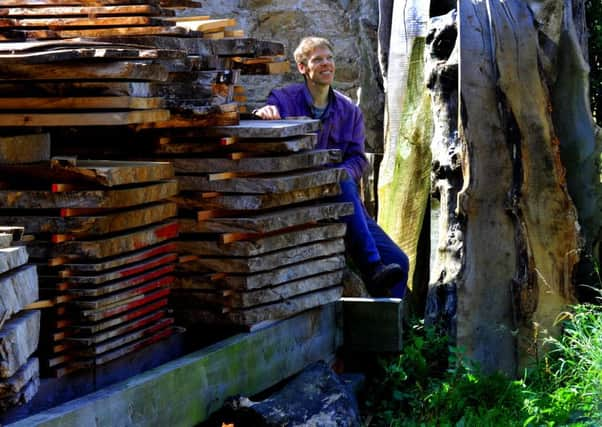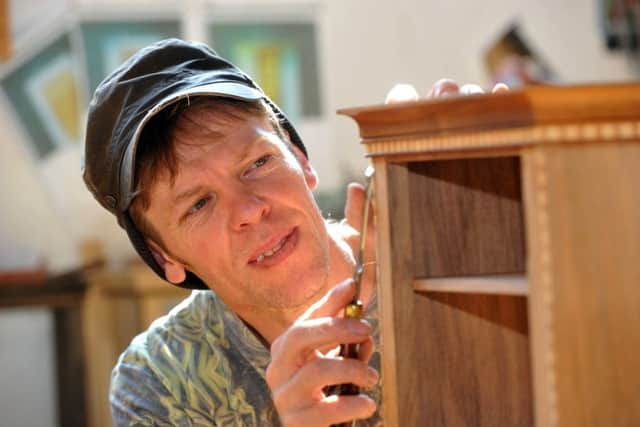Sawdust and magic


Everywhere you look there is wood: planks and pieces waiting to be used; old branches carved into corkscrew shapes; half-completed tables; a cabinet made from a Camphill Trust walnut tree, with hand-carved banding.
“The banding is made from apple and holly wood from York House, which is 500 yards away from here, and an under-banding of plum which was from just opposite this field by the hotel there,” says Mark, pointing vaguely towards the workshop door.
Advertisement
Hide AdAdvertisement
Hide AdHis business is called the Woodlark and he runs it from the Old Joiner’s Shop, in the Estate Yard, in Old Maltongate.


Mark makes beautiful things from wood, from chopping boards to tables, doors to picture frames, tables to chairs. For his own amusement, he also makes architectural shapes such as the 30-faced rhombic triacontahedron – “You’ll have to Google that.”
Although he makes fine furniture out of wood, Mark also believes that we should enjoy wood in its own right. He holds up a short plank of willow from Pickering, a beautifully rippled piece of timber.
“I could stop furniture making completely and still find the wood and polish these pieces up. People collect stones and shells as natural wonders, and these are natural wonders.”
Advertisement
Hide AdAdvertisement
Hide AdAt this point, it is worth explaining how Mark, who grew up in Worcester, found his way through the woods to Ryedale. Today he lives with his partner, Helen, and their two children, aged five and eight, in a house 150 yards from his workshop. Yet that domestic snapshot does not tell the whole story, as he began his affair with wood while living in a squat in Brixton, south London.


Mark studied interior design and architecture at the Royal College of Art, after doing a BA in interiors at Kingston University. Afterwards he worked on transforming spaces, but ran up against building control. Too many rules and regulations, he says.
“When you are coming from somewhere like the Royal College, you’re very creative, you’re very open-minded, then suddenly you get into the real world and you realise that you can’t do that.”
That was when he first considered timber. “Working with wood is quite friendly, it’s very tactile. And it seemed to be very natural and available and through that I started collecting wood from local parks.”
Advertisement
Hide AdAdvertisement
Hide AdHis years in London were fulfilling but hard. “I was virtually homeless. I was living quite a nomadic experience. Squatting at the time. There were quite a lot of us and we were trying to stop the council from selling off public buildings.”
He found plenty of work and survived the tough times by making tables, interiors, bar tops, small pieces of furniture and boxes, and had well-to-do clients including “photographers, super-models, actors”.
Yet now here he is in an old stable-block, surrounded by wood and warmed on cold days by the wood-burner he is reluctant to fill with wood (“Only shavings,” he says, as burning useful wood doesn’t seem right).
A deal over wood led him north. First, he bought a load of burr oak from a friend, Tony Wells, who ran a cabinet-making business in Malton. A year later, Wells emigrated and offered to pass on the business to Mark. So he left his London life, left too his occasional role as artist in residence at Brockwell Park, where he had a small building filled with wood. The wood came with him, of course, and some of it is still waiting to be used years later.
Advertisement
Hide AdAdvertisement
Hide Ad“For the first time in 10 years I started paying rent for the business here. It was hard. That’s one thing about living homeless is that you lose touch: things have a cost. It wasn’t all plain sailing, the homelessness – I must stress that. It wasn’t a free ride, but I loved the freedom.”
As he stands here in his overalls and peaked cap, showing me one wooden artefact after another, or explaining how patterns in wood are formed by the burrs, ripples, crotches and cankers, Mark seems both light and heavy. He is slim, hyperactive slim perhaps, and has a lightness of touch and a keenness of manner, yet he is serious too, about wood, about life, and about making beautiful furniture by hand, honouring the wood in a way no machine can.
Each piece he makes is a one-off, even if it starts from a standard design. “Once people realise they can make 20 of something with machines, it’s all about money then,” he says.
It takes six weeks to finish a piece of fine furniture, allowing time for the wood to settle and so forth. And nothing is ever on time. Is that the wood or you? “It’s just me. Something is nearly finished and you have a week left, and you think, ‘Do I rush it or spend more time on it?’ And I always choose to spend more time, just so the wood sings.”
Advertisement
Hide AdAdvertisement
Hide AdSometimes he first sees that piece of furniture as a tree in a Yorkshire forest. He likes to know where the wood comes from and brands his furniture with a stamp giving the location of the tree that he used.
“I’ll take my GPS tracker and sit with the tree or sit with the stump if the tree is already down. I’ll get my 14 satellites to come up and it’ll give me a longitude/latitude number, and those numbers then get transferred onto each piece of furniture.
“I am not just buying a board from a shop that sells timber. I am actually selecting logs for particular work or the rareness of the timber’s character.”
Mark has a small shop in the Shambles, Malton, open from 10am to 4pm on Friday and Saturday. In the window are assorted handmade chopping boards, each with its own shape. These cost between £30 and £60, although special boards could run to £300. Mark deals directly with customers, but also sells to galleries in London and elsewhere.
Advertisement
Hide AdAdvertisement
Hide AdSometimes he drives his van onto the Moors and works outdoors. That was how he had the idea for the chopping boards. When he first came to Yorkshire, Mark was amazed by the dry-stone walling and how people used to live. “I always imagined these big people with big coats on and keeping warm. And this is what inspired the shapes.”
Laid flat and the boards are for chopping, yet stand them up and they look like wooden sculptures of people, the Moors people as Mark calls them. “This is the mum, that’s the dad and this is the children. They’re all carved from pieces of burr oak from Yorkshire. They make a great ensemble of interesting things. That is my next big thing.”
Then it is time to leave Mark to his wood and his sawdust, to the planked trees drying outside, to the beautiful pieces of furniture waiting to be finished.
Likely as not he’ll be here late. He often starts early and pops home to see the children for breakfast. After an evening meal with the family, he will return and work until 10pm or so.
“If I’m at home watching TV, I just think of what I could be doing here,” he says.
Find out more at thewoodlark.com